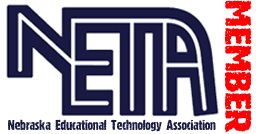Each year as the NETA (Nebraska Educational Technology Association) conference approaches, I get excited about all the possibilities this two-day conference offers. Each year, NETA brings in some very good keynoters and offers a wide variety of break out sessions. I am always amazed at how the conference unfolds each year.
Going to NETA?:
As in the past, you can use NETA’s website (
http://netasite.org) to find and select sessions that you are interested in attending. When you go to the website, look for the session search link, click on it, and you can look at the “Schedule-at-a-Glance.” Rushton Hurley will be a keynote and featured speaker this year at the conference. We featured his website in a past newsletter (
http://nextvista.org). On Friday, attendees will get to pick between Tony Vincent and Richard Byrne. We featured Richard’s website in the newsletter also (
http://freetechforteachers.com). If there are several teachers going from one district, you might consider selecting sessions you each can attend and then collaborating on notes. Another idea would be to use a Google Document in your district to take notes on sessions you attend. After the conference, your district representatives can use the document as a source for technology improvement in your district.
There are also “strands” for folks who have particular needs. A strand is a series of sessions that highlight a particular technology topic. The NETA Conference includes strands both days for tech support specialists, laptop environments, assistive technology, and more.
I find the conversations going on in the hallways between sessions, at the dinner table, and even during sessions are very valuable. Teachers and administrators from different districts get together to discuss how their schools are using different technologies. Questions get asked and a healthy discussion ensues. Those are conversations that cannot be replicated in your district.
Not going to NETA?:
Even if you are not able to attend the NETA conference, you still can become a member or follow the conference online or both. To become a member without going to the conference, simple go to the NETA website and click the Membership button on the left. The cost of membership per year is $25. By attending the conference, your membership is included in your registration. If you do not wish to become a member, but still want to get some benefit out of the conference, you can follow the conference online. NETA uses multiple forms of social media during and after the conference. You can follow by joining the NETA facebook page, checking NETA out on Twitter, Ning, YouTube, and Flickr. The keynote presentations are recorded (if allowed by the speaker), which can be viewed via a podcast at a later date. Featured presenters are also recorded. And, if you happen to find a session you really wanted to attend, the presenters can be contacted and you can get their handouts. By doing a session search on the NETA page, you can find the session and download any materials associated with that session.
What else do I need to know about NETA?
NETA is also an ISTE affiliate. ISTE is the International Society of Technology in Education. The NETA organization joins with approximately 70 other affiliated technology associations around the world. The mission of ISTE is
to advance excellence in learning and teaching through innovative and effective uses of technology. For schools and districts, ISTE has released NETS (National Educational Technology Standards) for teachers, students, and administrators. Not familiar with these standards? You can check them out at the ISTE site (
http://iste.org). ISTE also offers resources, such as books, from it’s online store for districts.
See you at NETA!
 Recently, I was able to sit in on a LiveScribe training with Engaging Technologies. I was able to follow along and think of ways to use this pen that I've heard about. When LiveScribe first came out, I was cautious thinking that it would be great for special education. After seeing the new features, I now know that it can be used in any educational setting (including college).
Recently, I was able to sit in on a LiveScribe training with Engaging Technologies. I was able to follow along and think of ways to use this pen that I've heard about. When LiveScribe first came out, I was cautious thinking that it would be great for special education. After seeing the new features, I now know that it can be used in any educational setting (including college).




